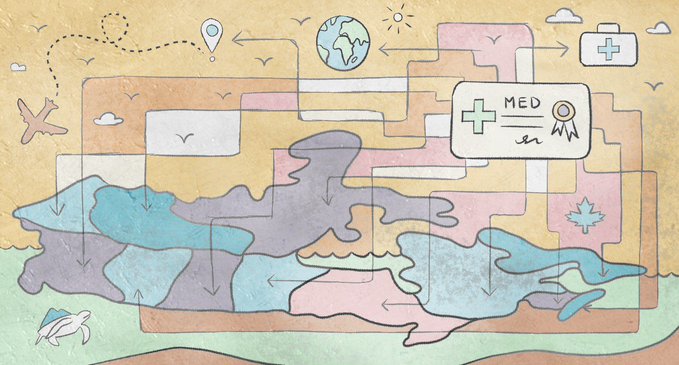National licensure, better virtual-care needed to fix system ‘close to the precipice’: CMA president
Leadership

This article was written in partnership with Healthy Debate, and is part of a series of seven articles that explore the relationship between technology and compassion in the field of health care today, and especially during the COVID-19 pandemic.
Author: Inori Roy
Illustrator: Winsome Adelia Tse
Of all the responsibilities anesthesiologists undertake in their day-to-day duties, there’s one Alika Lafontaine likes best: relieving pain during childbirth.
When you enter the room, he says, the patient is often wracked with pain. “So, you sit down, you do the procedure, and you give it time to start to work. And you can see the change happening, but they don’t necessarily see it.”
An anesthesiologist since 2011, Lafontaine is intimately familiar with the incremental changes that take place in a patient as the medicine takes effect. At first, the patient is only afraid things will get worse. But slowly, eventually, “There’s this moment – and this is my favourite moment – where you see the person start to trust that it’s actually going to work.”
To Lafontaine, this experience is analogous to the country’s recovery from COVID-19. People have been traumatized by the pandemic; they’re hurting, feeling anxious, and fearing for the future. And in his new capacity as president of the Canadian Medical Association (CMA) – the first Indigenous president in the organization’s more than 150-year history – he is trying to relieve worry and assure Canadians that the health-care system can and will get better.
Lafontaine sat down with Healthy Debate to talk about the challenges facing our health-care system as it grapples with pandemic recovery.
So, what is the primary issue facing Canadian health care?
From Lafontaine’s perspective, it’s a foundation-level crisis: patients are seeking care, and there aren’t enough people to provide it.
He is stepping into the role at a pivotal time for the Canadian medical community: a convergence of systemic and situational circumstances that have shaken health care to its core, raising fundamental questions about how, and whether, the system works. The pandemic has made clear the gaps in Canada’s medical system – most apparently, inequitable access and coverage on the basis of race, class and geography – and the degree to which it has been chronically underfunded.
“There was a shift that happened in the ’90s, when we started to whittle away at our health workforce, and the idea of free markets started to creep into health care,” Lafontaine says. “We started taking this approach of (asking) how we can maximize throughput with minimizing resources.
“(But) that doesn’t make any sense. You can’t cut yourself down to having enough.”
Now, after two years of crisis, health-care workers are exhausted and burnt out; in a CMA survey of doctors last November, nearly half said they were considering reducing their clinical work. And enveloping these factors is an atmosphere of polarization and misinformation around basic medical realities, seized by political leaders as “superficial expressions of actual core issues,” Lafontaine says.
In the long-term, repairing our country’s medical system needs to involve a change in the material and the rhetorical
The first instinct in such a maelstrom is to identify the problem – but “you actually have the information at your fingertips, if you’re willing to read through the material.” When it comes to Indigenous health care, for example, he points to the Assembly of First Nations’ Health Transformation Agenda. The 2017 report outlined the conditions and challenges impacting Indigenous health, highlighted community-led solutions and responses, and recommended policy options. Since this and countless other comprehensive reports have already been released, with little corresponding action, we don’t need more royal commissions or task forces, he says.
In the long-term, repairing our country’s medical system needs to involve a change in the material and the rhetorical – how much we invest in health care and what we believe it deserves; beyond that, who we think should be making those decisions and at what stage they should intervene. Right now, the political will to act only comes when the system is at a point of crisis, and “by that time, you’re so deep into the downward spiral that it costs more and takes more effort and more energy than if you could intervene earlier,” Lafontaine warns.
“I honestly don’t believe Canadians realize just how close to the precipice we are. People have gotten used to hearing that their surgeries have been cancelled three, four times (…) that there are no family doctors in their area. They’ve gotten used to hearing that even a walk-in clinic is booked up today,” he says. “We need to start believing differently about what we should expect.”
There are tangible, concrete solutions Lafontaine says we already could be implementing to bring the medical system back from the brink of crisis.
One of those is a national licensure system. Each province has its own set of licensing regulations, and doctors, nurses and other medical professionals are required to go through tedious applications and pay thousands in fees to gain the right to practice medicine outside of their province. The process is time consuming and intensive: in Ontario, for instance, there are more than 40 documents involved.
Lafontaine and others before him have argued that the inability to practice medicine across provinces disproportionately harms remote and rural communities, who make up 18 per cent of the population but are served by only 8 per cent of medical professionals, among whom rates of turnover are very high. In a 2019 CMA survey, more than 90 per cent of 6,000 doctors supported national licensure, and between 30-45 per cent said it would motivate them to pursue work across multiple jurisdictions in varying capacities. “The competition for health professionals in the country shouldn’t be ‘how can I keep someone here,’ ” Lafontaine says. “It should be ‘how can I create a system that is such a great place to work, that everyone wants to work here?’ ”
Lafontaine says the pandemic proved that when it is deemed necessary, political leaders are willing to allow for greater mobility among physicians. Last spring, when ICUs were overburdened, the Ontario government reached out to other provinces, requesting that more than 600 medical staff relocate to Ontario indefinitely to provide the necessary supports.
Lafontaine and others before him have argued that the inability to practice medicine across provinces disproportionately harms remote and rural communities.
Even outside of COVID, national licensure isn’t entirely unheard of: In the Canadian military, uniformed physicians need only be licensed in one province to provide services at military hospitals anywhere in the country. The foundational infrastructure for this mobility exists and is ready to be built upon – and it needn’t only be for the worst crises, Lafontaine emphasizes.
Though regulation of medical professionals takes place on a provincial level, “the provinces don’t have to give up the right to regulate professionals,” Lafontaine says. “They can give away certain parts of that responsibility to enable easier flow of professionals both across the country, and in and out of the country,” adding that national licensure additionally could allow for physicians trained abroad to more easily work in this country.
Critics and proponents of national licensure alike have mentioned that the process will be complicated and involve collaboration across different levels of government and between different medical authorities. Greater communication and streamlining between siloed levels of government and medical authorities is key not only to improving distribution of medical professionals but also to developing adaptable, inventive models of care, Lafontaine adds, including in the growing field of virtual care that has been touted as the solution to issues of inaccessibility for patients.
However, the way virtual care has been implemented has the potential to reinforce the same problems as in-person care, Lafontaine says. First off, rural and remote communities need the infrastructure to access virtual care, namely reliable internet and digital resources. But even beyond that, he adds, virtual care “can’t exist in isolation – otherwise it’s an intervention that has no endpoint.”
We often make the mistake of imagining access to health care as being able to go to the doctor and find the cure for our ailments, Lafontaine explains. But it’s almost never that easy. Health care requires a network of experts working together and communicating with each other: your primary doctor, knowing your history and understanding your problem, directing you to a pharmacist to provide you with the medication you need, or to a specialist, who will then work with a lab technician, who may be working with a third-party in testing … and on and on for however long your medical journey may last.
The way virtual care has been implemented has the potential to reinforce the same problems as in-person care
Within our current model of virtual care, we fail to take this web of experts into account, says Lafontaine, and instead imagine telehealth as a privatized, individualized experience. This model isn’t going to work. “It’s a health system, not a health encounter,” he says.
The Virtual Care Task Force (assembled by the CMA, the national College of Family Physicians and the Royal College of Physicians and Surgeons) recommended in February 2020 that virtual care be accompanied by strong standards and easily navigable licensing regulations across provincial and territorial boundaries. While their recommendations have yet to be met, the pandemic has made clear the need for solutions.
There’s potential for a perfect storm to unfold as we shift toward pandemic recovery. Physicians have expressed their enthusiasm for concrete solutions time and again, but this motivation needs to be accompanied by a vested public interest which, in turn, drives political will. Canadians need to understand they have the right to demand better of their medical system, and that change necessitates multiple levels of government working hand-in-hand, Lafontaine says.
“The real challenge is that, as a leader, you (must) have confidence that you could map out the future,” he says, returning to the lessons learned from anesthesiology. “I always explain to patients: I’m putting in this epidural, we won’t really know if it works until we have time to make sure. But if it doesn’t, I’ll be here to help you. And that’s a message a lot of us are craving from our political leaders.
“We need to know that they’re going to be there for us.”

